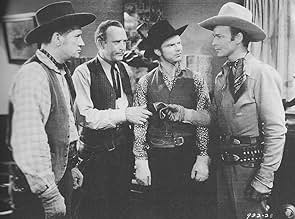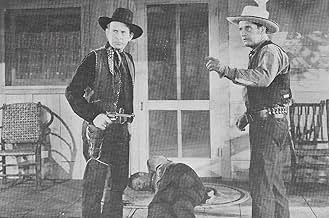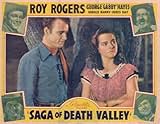Agrega una trama en tu idiomaIn the opening scene Roy as a boy philosophizes about marriage to his girl friend then sees his dad gunned down by bad guys who want to drive out the ranchers by cutting off their water.In the opening scene Roy as a boy philosophizes about marriage to his girl friend then sees his dad gunned down by bad guys who want to drive out the ranchers by cutting off their water.In the opening scene Roy as a boy philosophizes about marriage to his girl friend then sees his dad gunned down by bad guys who want to drive out the ranchers by cutting off their water.
- Dirección
- Guionistas
- Elenco
Don 'Red' Barry
- Jerry
- (as Donald Barry)
Hooper Atchley
- Dr. Ward
- (sin créditos)
Johnny Bond
- Band Member
- (sin créditos)
Fred Burns
- Wilson
- (sin créditos)
Horace B. Carpenter
- Man at Party
- (sin créditos)
Jess Cavin
- Henchman
- (sin créditos)
Opiniones destacadas
The shocking opening sets the stage when Rogers Sr. (Lane Chandler) refuses to falsify an assayer's report on water rights and is killed by Ed Tasker (Frank M. Thomas). Toddler Don 'Red' Barry is a witness and is kidnapped and raised by Tasker. So it's brother seeking brother and lover seeking lover where Doris Day comes in. She's not as famous as the later era Doris Day but just as beautiful.
Rogers ups the ante against the villains when he forms a vigilante group from among his cowhands. Great roles played by the best sidekick ever, Gabby Hayes and the best henchmen sidekick ever, Jack Ingram. Look for a great scene at the dam with Hal Taliaferro and a dazzling dance scene with Gabby and Fern Emmett.
When Roy Rogers was a boy, his father had owned a ranch in Death Valley. But fellow rancher and owner of the only source of water, Frank M. Thomas, had gunned his father down and and taken Roy's brother as his 'nephew'. Now Roy has returned under a fake name, with only Gabby Hayes to recognize him, to buy back the old spread and begin a war against Thomas, who's also running 'protection' against cattle rustling, under the charge of Roy's unremembering brother, Don Barry.
Rogers starred in nine movies for Republic in 1939, so he must have been pretty busy. That said, it's a good outing, well written by Karen DeWolf, and directed by the indefatigable Joseph Kane. That's the best way to become a star: good work and lots of it. Plus some decent songs, including "Peeping Through The Knothole."
Rogers starred in nine movies for Republic in 1939, so he must have been pretty busy. That said, it's a good outing, well written by Karen DeWolf, and directed by the indefatigable Joseph Kane. That's the best way to become a star: good work and lots of it. Plus some decent songs, including "Peeping Through The Knothole."
SAGA OF DEATH VALLEY (1939) is a lean, action-packed B-western about a land grabber in a generic ranch valley (no relation to the real Death Valley) who comes up against a new ranch owner who's willing to fight back. Roy Rogers stars as Roy Rogers, whose father owned the Circle R Ranch and was killed by land baron Ed Tasker (Frank M. Thomas) when Roy was an adolescent. Tasker had snatched Roy's younger brother, Tim, and raised him to be an outlaw, leading raids on other ranchers' stock and forcing all the ranchers in Death Valley to pay protection to Tasker. When Roy comes back to the valley as an adult he forms the Death Valley Riders to combat Tasker's efforts. This gets him into a confrontation with his own brother, although neither knows their family connection. Roy also hooks up with Ann, his childhood sweetheart (played by Doris Day, an actress who left movies five years before the more famous Doris Day turned up at Warner Bros. in 1948). Because of the complicated family history at the root of the film's drama there is a richer subtext than usual for a Rogers western and a more tragic ending.
The film is beautifully photographed by Republic Pictures house cameraman Jack Marta, much of it on location in the area around Lone Pine, California in the foothills of the Sierras. The action is fast and furious and the cast includes lots of Republic Pictures regulars, most notably Gabby Hayes as Roy's ranch foreman. Donald Barry plays Jerry, who's secretly Roy's brother Tim. Barry would next co-star as Jesse James with Roy in DAYS OF JESSE JAMES (1939) and went on to forge a notable career as a B-western star in his own right. He didn't sing and had a darker quality than most western heroes, making him, in all likelihood, the first B-western anti-hero.
The film is beautifully photographed by Republic Pictures house cameraman Jack Marta, much of it on location in the area around Lone Pine, California in the foothills of the Sierras. The action is fast and furious and the cast includes lots of Republic Pictures regulars, most notably Gabby Hayes as Roy's ranch foreman. Donald Barry plays Jerry, who's secretly Roy's brother Tim. Barry would next co-star as Jesse James with Roy in DAYS OF JESSE JAMES (1939) and went on to forge a notable career as a B-western star in his own right. He didn't sing and had a darker quality than most western heroes, making him, in all likelihood, the first B-western anti-hero.
While westerns endure in one form or another, and some are surely among the best movies ever made, not every variety thereof stands as tall now as they might have in years past. Roy Rogers is certainly best known for his antics as a singing cowboy, a genre that's decidedly gauche and carries old-fashioned sensibilities that today are most associated with early sitcoms of 1950s television. This doesn't mean that they can't be earnestly worthy and enjoyable, but even at their best they tend to be very direct in their storytelling, which itself is an odd flavor characteristic of their contemporary pictures. Suffice to say that such movies may not appeal to all viewers - though it should be noted that in this case, 'Saga of Death Valley' rather deemphasizes songs compared to some of Roy Rogers' other pictures, and also adopts a slightly darker tone. Still brusque in its plot development (including the jarringly sudden ending), ham-handed at times (there are, yes, fragments of song), and otherwise claiming some of the same indelicacies or inelegance, there's no confusing that it's cut from the same cloth. But for what is done particularly well here: for those who have especial difficulty with such fare, this could be a relatively fair point of entry, and it's definitely gratifyingly strong at large.
The plot bears familiar strains of small town corruption, with bad guys taking advantage of the innocence, virtue, and peace of ordinary folks. That's perfectly fine, though, for it's a compelling story even if it smacks of something we've seen before. Furthermore, this rendition can boast a couple small details that help it to stand apart a little bit, with the result that the film is even more engaging, and even genuinely thrilling. More, perhaps, than some comparable titles, there are a lot of action sequences here, and Joseph Kane's practiced direction realizes them all with terrific finesse, stunts included. Even where action is sidelined, any lighter (and cheesier) moments are counterbalanced by harsh drama that's decidedly a bit more dreary than what we've gotten from some of this picture's brethren. It's a credit to screenwriters Karen DeWolf and Stuart Anthony that 'Saga of Death Valley' kind of bucks the trend of Rogers' other features and focuses so squarely on a more robust notion of storytelling. Why, I might go so far as to say that while the presentation here is emphatically curt, the substance of the narrative is just as meaningfully absorbing as what we might hope for from any western of the years to follow.
The chief weakness, I think, is in the editing. Sound (including music on the soundtrack) cuts abruptly and roughly at no few points, or even prematurely before the sequencing of the imagery catches up. Lester Orlebeck's editing in the latter capacity is less glaringly faulty but still far from perfect, primarily in that it's simply overzealous. Not least during action scenes, we sometimes get such a rapid-fire burst of movement from shot to shot that the value of each is dampened; it's the same deficiency that plagues even modern action flicks, substituting the empty flash of the cutting room floor for the major impact that a melee strike, stunt, or effect could have if we actually, fully saw it. Seeing as how this clocks in at under an hour, the picture would have lost nothing whatsoever if even just a scattered few shots were allowed to linger longer, letting us truly soak them in. On the other hand, much more so than not this is quite well made. Jack A. Marta's cinematography is active and dynamic, a credit to his skill, and all the crew behind the scenes put in good work. The production design, art direction, costume design, hair and makeup work, and props are all just as splendid as we expect from the genre, helping us get into the spirit of the Wild West. It may be kitschy at times, with a couple weak spots in the writing, and the editing is troubled. Yet far and away 'Saga of Death Valley' is a much better and more satisfying film than I'd have possibly assumed sights unseen.
Anyone who has difficulties abiding older films, westerns, or this picture's kin may not have their minds changed strictly speaking, though it's possible that this title is just different enough that it could serve as a gateway. For wider audiences, however, I believe this 1939 feature is so well done, engrossing and even exciting, that it does, indeed, stand tall and remain quite worth watching even more than 80 years later. Don't feel like you need to go out of your way for it, but if you have the opportunity to watch, I'm as surprised as anyone at just how solid 'Saga of Death Valley' is, and I'm pleased to say it earns my hearty recommendation!
The plot bears familiar strains of small town corruption, with bad guys taking advantage of the innocence, virtue, and peace of ordinary folks. That's perfectly fine, though, for it's a compelling story even if it smacks of something we've seen before. Furthermore, this rendition can boast a couple small details that help it to stand apart a little bit, with the result that the film is even more engaging, and even genuinely thrilling. More, perhaps, than some comparable titles, there are a lot of action sequences here, and Joseph Kane's practiced direction realizes them all with terrific finesse, stunts included. Even where action is sidelined, any lighter (and cheesier) moments are counterbalanced by harsh drama that's decidedly a bit more dreary than what we've gotten from some of this picture's brethren. It's a credit to screenwriters Karen DeWolf and Stuart Anthony that 'Saga of Death Valley' kind of bucks the trend of Rogers' other features and focuses so squarely on a more robust notion of storytelling. Why, I might go so far as to say that while the presentation here is emphatically curt, the substance of the narrative is just as meaningfully absorbing as what we might hope for from any western of the years to follow.
The chief weakness, I think, is in the editing. Sound (including music on the soundtrack) cuts abruptly and roughly at no few points, or even prematurely before the sequencing of the imagery catches up. Lester Orlebeck's editing in the latter capacity is less glaringly faulty but still far from perfect, primarily in that it's simply overzealous. Not least during action scenes, we sometimes get such a rapid-fire burst of movement from shot to shot that the value of each is dampened; it's the same deficiency that plagues even modern action flicks, substituting the empty flash of the cutting room floor for the major impact that a melee strike, stunt, or effect could have if we actually, fully saw it. Seeing as how this clocks in at under an hour, the picture would have lost nothing whatsoever if even just a scattered few shots were allowed to linger longer, letting us truly soak them in. On the other hand, much more so than not this is quite well made. Jack A. Marta's cinematography is active and dynamic, a credit to his skill, and all the crew behind the scenes put in good work. The production design, art direction, costume design, hair and makeup work, and props are all just as splendid as we expect from the genre, helping us get into the spirit of the Wild West. It may be kitschy at times, with a couple weak spots in the writing, and the editing is troubled. Yet far and away 'Saga of Death Valley' is a much better and more satisfying film than I'd have possibly assumed sights unseen.
Anyone who has difficulties abiding older films, westerns, or this picture's kin may not have their minds changed strictly speaking, though it's possible that this title is just different enough that it could serve as a gateway. For wider audiences, however, I believe this 1939 feature is so well done, engrossing and even exciting, that it does, indeed, stand tall and remain quite worth watching even more than 80 years later. Don't feel like you need to go out of your way for it, but if you have the opportunity to watch, I'm as surprised as anyone at just how solid 'Saga of Death Valley' is, and I'm pleased to say it earns my hearty recommendation!
Yikes. "Roy Rogers" gets assassinated. Why didn't I know? Oh no, wait - it was the senior version! The junior version returns many years after to find his murderer "Tasker" (Frank M. Thomas) is holding the ranchers to ransom over the water supply and that his enforcer is none other than his own kid brother "Jerry" (Don Barry). Fortunately, "RR" also has the ever-reliable "Gabby" ("Gabby" Hayes) on his side as his incognito attempt to rally the other ranchers gathers an increasingly perilous momentum. As a kid, I was not a fan of "Roy Rogers" and that was because the crooning just doesn't belong in a western (well not unless it was Dean Martin) but here, luckily, there is a good deal less of that and more of a story to unfold than you might expect, only with a few hiccups along the way and even the tiniest bit of romance threatening for "Gabby" with the redoubtable "Miss Minnie" (Fern Emmett) and her ever so frilly gowns. There's more action here than usual too, and the gun totin' livens up nicely towards the conclusion of quite a busy little hour of reconciliation and revenge. No, you might never recall watching it afterwards, but it passes the time amiably enough and with a bit more of Hayes to get our teeth into, this one is worth a gander.
¿Sabías que…?
- TriviaFilm debut of Jimmy Wakely.
- Bandas sonorasSong of the Bandit
Written by Bob Nolan
Selecciones populares
Inicia sesión para calificar y agrega a la lista de videos para obtener recomendaciones personalizadas
Detalles
- Tiempo de ejecución58 minutos
- Color
- Relación de aspecto
- 1.37 : 1
Contribuir a esta página
Sugiere una edición o agrega el contenido que falta

Principales brechas de datos
By what name was Saga of Death Valley (1939) officially released in India in English?
Responda


































